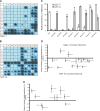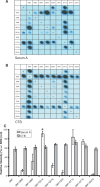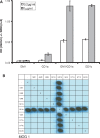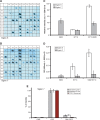Analysis of lectin binding to glycolipid complexes using combinatorial glycoarrays
- PMID: 19349623
- PMCID: PMC2688392
- DOI: 10.1093/glycob/cwp049
Analysis of lectin binding to glycolipid complexes using combinatorial glycoarrays
Abstract
Glycolipids are major components of the plasma membrane, interacting with themselves, other lipids, and proteins to form an array of heterogeneous domains with diverse biological properties. Considerable effort has been focused on identifying protein binding partners for glycolipids and the glycan specificity for these interactions, largely achieved through assessing interactions between proteins and homogenous, single species glycolipid preparations. This approach risks overlooking both the enhancing and attenuating roles of heterogeneous glycolipid complexes in modulating lectin binding. Here we report a simple method for assessing lectin-glycolipid interactions. An automatic thin-layer chromatography sampler is employed to create easily reproducible arrays of glycolipids and their heterodimeric complexes immobilized on a synthetic polyvinyl-difluoride membrane. This array can then be probed with much smaller quantities of reagents than would be required using existing techniques such as ELISA and thin-layer chromatography with immuno-overlay. Using this protocol, we have established that the binding of bacterial toxins, lectins, and antibodies can each be attenuated, enhanced, or unaffected in the presence of glycolipid complexes, as compared with individual, isolated glycolipids. These findings underpin the wide-ranging influence and importance of glycolipid-glycolipid cis interactions when the nature of protein-carbohydrate recognition events is being assessed.
Figures




Similar articles
-
Combinatorial glycoarray.Methods Mol Biol. 2012;808:413-23. doi: 10.1007/978-1-61779-373-8_28. Methods Mol Biol. 2012. PMID: 22057541
-
Detection of Autoantibodies Using Combinatorial Glycolipid Microarrays.Methods Mol Biol. 2022;2460:183-191. doi: 10.1007/978-1-0716-2148-6_11. Methods Mol Biol. 2022. PMID: 34972937
-
Heteromeric glycolipid complexes as modulators of autoantibody and lectin binding.Prog Lipid Res. 2010 Jan;49(1):87-95. doi: 10.1016/j.plipres.2009.09.001. Epub 2009 Sep 6. Prog Lipid Res. 2010. PMID: 19735674 Review.
-
Polyisobutylmethacrylate modifies glycolipid binding specificity of verotoxin 1 in thin-layer chromatogram overlay procedures.Anal Biochem. 1992 Apr;202(1):188-92. doi: 10.1016/0003-2697(92)90226-w. Anal Biochem. 1992. PMID: 1621981
-
Determination of glycolipid-protein interaction specificity.Methods Enzymol. 2006;417:205-20. doi: 10.1016/S0076-6879(06)17015-9. Methods Enzymol. 2006. PMID: 17132507 Free PMC article. Review.
Cited by
-
Anti-ganglioside antibodies are removed from circulation in mice by neuronal endocytosis.Brain. 2016 Jun;139(Pt 6):1657-65. doi: 10.1093/brain/aww056. Epub 2016 Mar 26. Brain. 2016. PMID: 27017187 Free PMC article.
-
The GD1a glycan is a cellular receptor for adenoviruses causing epidemic keratoconjunctivitis.Nat Med. 2011 Jan;17(1):105-9. doi: 10.1038/nm.2267. Epub 2010 Dec 12. Nat Med. 2011. PMID: 21151139
-
Anti-GM2 ganglioside antibodies are a biomarker for acute canine polyradiculoneuritis.J Peripher Nerv Syst. 2013 Mar;18(1):75-88. doi: 10.1111/jns5.12011. J Peripher Nerv Syst. 2013. PMID: 23521648 Free PMC article.
-
Exploration of sialic acid diversity and biology using sialoglycan microarrays.Biopolymers. 2013 Oct;99(10):650-65. doi: 10.1002/bip.22314. Biopolymers. 2013. PMID: 23765393 Free PMC article. Review.
-
Binding Cooperativity Matters: A GM1-Like Ganglioside-Cholera Toxin B Subunit Binding Study Using a Nanocube-Based Lipid Bilayer Array.PLoS One. 2016 Apr 12;11(4):e0153265. doi: 10.1371/journal.pone.0153265. eCollection 2016. PLoS One. 2016. PMID: 27070150 Free PMC article.
References
-
- Avril T, North SJ, Haslam SM, Willison HJ, Crocker PR. Probing the cis interactions of the inhibitory receptor Siglec-7 with alpha2,8-disialylated ligands on natural killer cells and other leukocytes using glycan-specific antibodies and by analysis of alpha2,8-sialyltransferase gene expression. J Leukoc Biol. 2006;80(4):787–796. - PubMed
-
- Boffey J, Nicholl D, Wagner ER, Townson K, Goodyear C, Furukawa K, Furukawa K, Conner J, Willison HJ. Innate murine B cells produce anti-disialosyl antibodies reactive with Campylobacter jejuni LPS and gangliosides that are polyreactive and encoded by a restricted set of unmutated V genes. J Neuroimmunol. 2004;152(1-2):98–111. - PubMed
-
- Boffey J, Odaka M, Nicoll D, Wagner ER, Townson K, Bowes T, Conner J, Furukawa K, Willison HJ. Characterisation of the immunoglobulin variable region gene usage encoding the murine anti-ganglioside antibody repertoire. J Neuroimmunol. 2005;165(1-2):92–103. - PubMed
Publication types
MeSH terms
Substances
Grants and funding
LinkOut - more resources
Full Text Sources
Other Literature Sources

